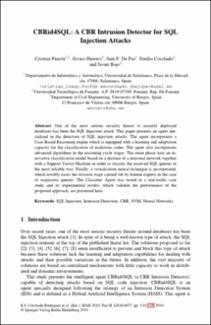| dc.contributor.author | Pinzón Trejos, Cristian | |
| dc.contributor.author | Herrero, Álvaro | |
| dc.contributor.author | De Paz, Juan | |
| dc.contributor.author | Corchado, Emilio | |
| dc.contributor.author | Bajo, Javier | |
| dc.date.accessioned | 2018-06-05T19:20:00Z | |
| dc.date.available | 2018-06-05T19:20:00Z | |
| dc.date.issued | 06/23/2010 | |
| dc.date.issued | 06/23/2010 | |
| dc.identifier.uri | http://ridda2.utp.ac.pa/handle/123456789/4783 | |
| dc.description | One of the most serious security threats to recently deployed databases has been the SQL Injection attack. This paper presents an agent specialised in the detection of SQL injection attacks. The agent incorporates a Case-Based Reasoning engine which is equipped with a learning and adaptation capacity for the classification of malicious codes. The agent also incorporates advanced algorithms in the reasoning cycle stages. The reuse phase uses an innovative classification model based on a mixture of a neuronal network together with a Support Vector Machine in order to classify the received SQL queries in the most reliable way. Finally, a visualisation neural technique is incorporated, which notably eases the revision stage carried out by human experts in the case of suspicious queries. The Classifier Agent was tested in a real-traffic case study and its experimental results, which validate the performance of the proposed approach, are presented here. | en_US |
| dc.description.abstract | One of the most serious security threats to recently deployed databases has been the SQL Injection attack. This paper presents an agent specialised in the detection of SQL injection attacks. The agent incorporates a Case-Based Reasoning engine which is equipped with a learning and adaptation capacity for the classification of malicious codes. The agent also incorporates advanced algorithms in the reasoning cycle stages. The reuse phase uses an innovative classification model based on a mixture of a neuronal network together with a Support Vector Machine in order to classify the received SQL queries in the most reliable way. Finally, a visualisation neural technique is incorporated, which notably eases the revision stage carried out by human experts in the case of suspicious queries. The Classifier Agent was tested in a real-traffic case study and its experimental results, which validate the performance of the proposed approach, are presented here. | en_US |
| dc.format | application/pdf | |
| dc.language | eng | |
| dc.language.iso | eng | en_US |
| dc.rights | https://creativecommons.org/licenses/by-nc-sa/4.0/ | |
| dc.rights | info:eu-repo/semantics/openAccess | |
| dc.subject | SQL Injection | en_US |
| dc.subject | Intrusion Detection | en_US |
| dc.subject | CBR | en_US |
| dc.subject | SVM | en_US |
| dc.subject | Neural Networks | en_US |
| dc.subject | SQL Injection | |
| dc.subject | Intrusion Detection | |
| dc.subject | CBR | |
| dc.subject | SVM | |
| dc.subject | Neural Networks | |
| dc.title | CBRid4SQL: A CBR Intrusion Detector for SQL Injection Attacks | en_US |
| dc.type | info:eu-repo/semantics/article | |
| dc.type | info:eu-repo/semantics/publishedVersion | |
